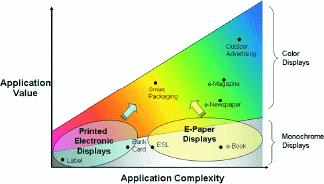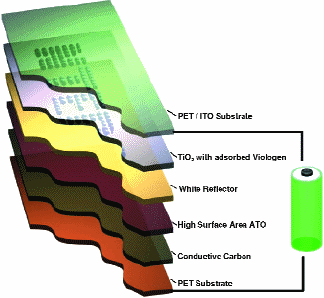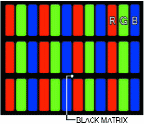Electrochromics: Unlocking Color in Electronic Paper
The next step in the evolution of e-paper is to improve its ability to reproduce color images. Some experts have pegged electrochromic technology as the strongest contender to lead to color e-paper displays. This article examines how electrochromics stack up when compared to other e-paper display technologies.
by Chris Giacoponello and Henrik Lindstrom
CONSIDER FOR A MOMENT just how pervasive printed paper is in today's society. Globally, about 300 million metric tons of paper and paperboard are produced each year. More than 2 billion books, 350 million magazines, and 24 billion newspapers are published annually1 – it is estimated that 45 trillion pages are printed each year, the vast majority of which are now printed in color. These are formidable numbers! This does not even include various paper products, packaging, posters, labels, cards, and signs. This is an extensive range of applications, with different economic values ascribed to the many different uses.
Despite the broad range of usage, certain attributes are common among all of these conventional paper-industry applications:
• They support high-contrast readable print on a flexible medium.
• They are enabled by low-cost high-volume printing.
• They are capable of supporting a broad range of natural color.
These traits point to several important paradigms that must be considered by the information-display industry in its attempts to develop an electronic medium to augment or displace printed paper in several or more of its current roles. First, the user experience offered by an electronic display must suit the human reading experience (optically and ergonomically) as well as printed paper. Secondly, e-paper must be capable of supporting a broad array of uses at very low price points – paper is successful and ubiquitous for this very reason. Finally, and perhaps most importantly, if e-paper displays are going to evolve from niche market applications to broad and pervasive deployment, they must be capable of supporting rich, vibrant, natural colors.

Fig. 1: Emerging market dynamics for e-paper and printed-electronic displays.
This article will examine the emergence of early e-paper technologies and compare the suitability of those technologies to e-paper applications in the long term. Because physical limitations relative to color rendering limit the widespread adoption of these early tech-nologies to niche applications (such as e-books), this article will identify and explore technologies that are candidates to overcome these shortcomings and the concurrent developments required to bring these longer-term solutions to market.
Emergence of e-Paper and Printed Electronics
Recently, the first commercial products containing early e-paper display technologies have reached the market. The applications primarily targeted thus far have been electronic-reading appliances (portable electronic reading devices) and shelf-edge price labels.
The most widely utilized e-paper display technology at this time is the electrophoretic display (EPD), which offers good readability, low power consumption, and compatibility with flexible substrates. Several companies manufacture EPD displays, including SiPix Imaging (microcell electrophoretic particles), E Ink (micro-encapsulated imaging films), and Bridgestone (air-gap particle system).
At the same time that e-paper is finding its way to the market through displays, a new industry based on printed electronics has emerged and is having a major impact on the traditional printing industry by bringing electronics into the domain of paper and plastic. The desire to incorporate smart electronics into printed products (labels, packaging, cards, and signs) has created this new industry, which is based on "functional printing." Through the use of conventional printingprocesses such as screen, flexo, gravure, and offset, functional e-inks can be printed in an additive manner on high-speed roll-to-roll print lines. This allows for the creation of simple, low-cost electronics and electro-optic functionalities on flexible substrates.
Taken together, these two market trends provide some evidence of the latent demand for these new applications. However, the mainstream adoption of e-paper and printed-electronics applications will require a combination of a paper-like user experience, low cost, high-volume printing, and color. Figure 1 illustrates the emerging market dynamics and future value migration for printed electronic displays and early market e-paper displays by comparing the relative value versus application complexity for several representative target products.
NanoChromics™ Technology: A Printed Electrochromic Color Display
Recent advancements in electrochromic technology based on the use of electrodes constructed from modified porous nanocrystalline films2 pioneered by NTERA Limited offer several significant advantages that enable the use of this technology in advanced digital displays. These include a paper-like optical quality with excellent contrast in all lighting conditions, rapid switching speed, very low power consumption for content with high-information hold times, a device structure that is fully compatible with low cost, additive print process manufacturing, and a full range of natural reflective colors.
The monolithic NanoChromics™ display structure shown in Fig. 2 consists of several stacked porous layers that are printed on top of each other on a substrate modified with a transparent conductor (such as ITO or PSS PDOT). Each printed layer has a specific function. The TiO2 with adsorbed viologen changes color by reduction or oxidation of the viologen molecules. The white reflector layer serves the purpose of increasing the contrast ratio and insulates the TiO2 layer electrically from the ATO. The ATO layer has high capacitance and counter-balances the charge inserted/extracted in TiO2 to maintain overall device charge neutrality. The conducting carbon layer adds extra capacitance and serves as a highly conductive back contact for the ATO.
In the last printing step (not indicated in Fig. 2), the porous monolith structure is overprinted with a liquid or polymer-gel electrolyte, dried, and then finally sealed with a PET film. The device can be switched on by applying a negative electrical potential to the transparent conducting substrate relative to the conductive carbon layer. This causes a reduction of viologen molecules (coloration) to occur at the TiO2 layer. By reversing the applied potential, the viologens oxidize and the device bleaches.

Fig. 2: A printed NanoChromics™ paper-like display.
A unique feature of the electrochromic monolith is the relatively low voltage (~1 V) needed to color and bleach the device. This can be explained by the small overpotentials (losses) needed to drive the electrochemical reduction of the surface adsorbed viologen, and the small overpotentials needed to drive the migration of the charge-compensating ions in the pores of the monolith. As a direct positive consequence of the low-voltage requirements, the device power consumption becomes relatively low as well. Switching speeds in the millisecond range have been obtained.3
The amount of coloration can be tuned continuously by controlling the amount of injected/extracted charge. By using transparent TiO2 layers with high densities of adsorbed viologens in combination with an optimized white reflector, intense colors with high contrast ratios can be obtained.2 A full color spectrum can be achieved by appropriate design and combination of dye molecules.4
The printing inks are based on non-toxic readily formulated materials such as carbon, TiO2, ATO, and small amounts of dye. All active layers can be deposited using conventional batch processes such as screen printing or continuous roll-to-roll processes such as flexography. The structure for these printed devices is shown in Fig. 2.
NanoChromics™ displays have demonstrated performance and reliability that is consistent with the needs of advanced display applications. Through a combination of improvements in molecular technology, materials, and compensatory electronic drive circuitry, the performance of NCD™ devices has been demonstrated to meet the needs of commercial device applications. NCD™displays on glass have been shipped in consumer products with lifetime performance requirements of at least 10 years, while accelerated lifetime testing in the laboratory has demonstrated capabilities exceeding 10 years and more than 40 million cycles.
The transition to flexible substrates with the printed monolithic architecture enables fundamental advancements in device flexibility and lower cost solutions. The monolithic architecture builds all of the layers on a single substrate (like printed media today), and as such supports flexing and bending in ways that are not possible with conventional displays based upon two parallel spaced-apart substrates. In addition, the cost advantages of an all-printed device based on a single substrate and no back-end assembly requirements are considerable, opening the door to functional applications that will compete with conventional printed media. A printed monolithic NCD™ display on PET is shown in Fig. 3.
Toward a Printed Color Future
Today, most flat-panel displays produce color using a planar RGB color filter, as shown in Fig. 4. While an RGB scheme can produce a broad, rich color gamut when used in an emissive display (where the light mixes in an additive manner), the results are significantly worse when used on a reflective display.
A significant amount of the reflected light is lost (through transmission and absorption losses), reducing the overall luminance and the impact of the perceived color on the eye. In fact, the maximum white-state reflectivity is 33% less than that of an equivalent mono-chrome display.5 While the luminance can be improved by desaturating the colors within the filters, this further reduces the color gamut that the display can reproduce.6
Moving forward, it is widely accepted that the best solution for reproducing deep, rich color on a reflective display will be achieved through an architecture that supports stacked color. Among the leading candidate tech-nologies for achieving stacked color are cholesteric LCD (Ch-LCD) and electrochromic.

Fig. 3: A printed monolithic NCD™ display on PET is shown. The display is connected to a flat battery with printed silver traces.
Several prototype stacked RGB Ch-LCDs have been demonstrated by Kent Displays, Inc. Recent investigations into a sequentially coated emulsion of Ch-LCD droplets in a polymer matrix have demonstrated the possibility of developing a printed stacked color architecture.7 Magink is in the process of commercializing a stacked RGB Ch-LCD solution to address the growing market for outdoor advertising.
These early stacked color displays are promising, and they provide an observable improvement in color rendering over planar RGB filters. However, there are several technical barriers to achieving rich, natural color. Specifically, the color is rendered through spectral reflection (not absorption) in narrow wavelengths, limiting the color gamut. Additionally, critical cell gaps or droplet uniformity must be maintained to achieve optimal color rendering, resulting in significant color shifting with angle when deployed on flexible substrates.
Ultimately, a fully printed light-absorbing natural-color display will provide the best solution for rendering true color. This may be achieved through a planar array of poly-chromatic pixels or a stacked, subtractive array of CMY inks. Electrochromic displays are cap-able of supporting both architectures, although realization of suitable poly-chromatic electro-chromic molecules has remained elusive.
Figure 5 illustrates an architectural diagram of a full-color printed CMY stacked NCD™ e-paper display. Today, this display architecture is gated primarily by the advancements and commercializations of transparent printed OTFTs. Recent advancements in the field of printed electronic transistors are promising. Several companies have indicated success in developing printed organic electronic transistors, with several of these devices now achieving mobilities of 80 cm2/V-sec. As a result, we anticipate that a fully printed, stacked NCD™ CMY/CMYK display may be realizable in the near future.
Conclusions
The introduction of electronic readers with EPD displays, such as the Sony Reader and Amazon's Kindle, and the emergence of "smart" shelf labels enabled by printed electronics are clear indications that the era of e-paper displays has arrived. In order to move from niche market applications (e-books and printed labels) to more widespread adoption, e-paper display technologies must provide a user experience that is consistent with printed paper, support low-cost printed manufacturing, and be capable of vibrant, natural color.
Many reflective-display technologies have demonstrated a readable reflective contrast, and several more can support high-volume fully printed manufacturing environments consistent with printed electronics. A limited number of others have demonstrated early success at stacked color architectures. However, electrochromics are ideally suited to support all three of these essential capabilities through the realization of an all-printed subtractive color display.
Finally, to really appreciate the importance of color in the printed media markets, consider the following: e-newspapers and e-magazines are frequently identified as a target market application for portable e-paper displays. However, the primary revenue model for newspapers and magazines (unlike books) is not driven by content; it is driven by advertising. In today's market, color is essential for effective advertising. It is reasonable to expect that these applications will struggle to gain traction without an e-paper display technology that can compete with printed color paper.
References
1www.tappi.org.
2U. Bach, et al., Adv. Mater.14, No. 11, 845 (2002).
3Cummins, et al., J. Phys. Chem. B 104, 11449-11459 (2000).
4D. Corr, et al., Solid-State Ionics 165, 315–321 (2003).
5M. A. Mossman, et al., "New Reflective Color Display Technique Based on Total Internal Reflection and Subtractive Color Filtering,"SID Symposium Digest Tech Papers 32, 1054 (2001).
6P. S. Drzaic, "The Emergence and Evolution of Electronic Paper," SID Applications Tutorial Notes (2005).
7I. Shiyanovskaya, et al., SID Symposium Digest Tech Papers 38, 65 (2007). •

Fig. 4: An RGB color filter.

Fig. 5: A stacked NCD™ CMY display.
Chris Giacoponello is the Vice President of Business Development and Marketing for NTERA, Inc.; telephone 484/534-2143, e-mail: chris.giacoponello@ntera.com. Henrik Lindstrom is a Senior Scientist at NTERA Limited; e-mail: henrik.lindstrom@ntera.com